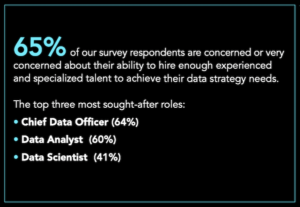
Ocient Report Chronicles the Rise of Hyperscale Data

Ocient, vendor of a hyperscale data warehouse platform, has released a new report, “Beyond Big Data: The Rise of Hyperscale,” which found that 85% of C-level leaders see a strong link between the financial success of their organization and faster data analysis.
The report details how companies are moving beyond the volumes of data traditionally categorized as big data into much larger hyperscale data sets comprising trillions of data records that must be ingested, stored, and analyzed quickly to extract their value. Compiled from a survey of 500 data and technology leaders who are managing active data workloads of 150 terabytes or more, the report explains how the shift from big data to hyperscale data involves challenges as well as opportunities for growth.
Ocient highlights the following key findings of the report:
- Data analysis is tied to financial success. More than 85% of C-level respondents indicated there is a strong relationship between implementing faster data analytics and growing the company’s bottom line.
- Data workloads are getting bigger, faster and more complex. Ninety-seven percent of respondents indicated the volume of data managed by their organization will grow fast to very fast over the next one to five years.
- Legacy systems aren’t built to handle hyperscale data analysis. More than 59% of respondents plan to switch data warehousing solutions, and 46% of respondents indicated a legacy system is motivating them to switch.
- Security and compliance are among top concerns. Sixty-three percent of respondents said maintaining security and compliance is a challenge in scaling data volumes and analytics to hyperscale workloads.
- Staffing is a challenge. Forty-nine percent of respondents wrote there is a lack of talent to analyze their data.
![]() Experts are forecasting exponential data growth in the next few years. Research from the IDC Global DataSphere, a measure of how much new data is created, captured, replicated, and consumed each year, shows that global data is estimated to grow substantially: “The Global DataSphere is expected to more than double in size from 2022 to 2026. The Enterprise DataSphere will grow more than twice as fast as the Consumer DataSphere over the next five years, putting even more pressure on enterprise organizations to manage and protect the world’s data while creating opportunities to activate data for business and societal benefits,” said John Rydning, research vice president of the IDC Global DataSphere.
Experts are forecasting exponential data growth in the next few years. Research from the IDC Global DataSphere, a measure of how much new data is created, captured, replicated, and consumed each year, shows that global data is estimated to grow substantially: “The Global DataSphere is expected to more than double in size from 2022 to 2026. The Enterprise DataSphere will grow more than twice as fast as the Consumer DataSphere over the next five years, putting even more pressure on enterprise organizations to manage and protect the world’s data while creating opportunities to activate data for business and societal benefits,” said John Rydning, research vice president of the IDC Global DataSphere.
The IDC research also showed that 64.2 zettabytes of data was created or replicated in 2020 alone, and if current rates continue, more than 180 zettabytes (or 180 billion terabytes) will be created in 2025.
Ocient’s survey reflects this data growth forecast in respondents’ assessment of how fast the volume of data managed by their organization will grow over the next one to five years: 97% of those surveyed answered “fast” to “very fast,” and 72% of C-level executives expecting “very fast” data growth over the next five years.
Ocient says the most successful companies aren’t just collecting this unprecedented amount of data but are actually analyzing it, too. With such substantial growth in data volumes comes the need for expanding analytics capabilities, and 98% of survey respondents agree it is somewhat or very important to increase how much data is being analyzed in the next one to three years. Barriers arise with hyperscale data analytics, however, and the top three limiting factors cited were: the volume of data is growing too fast (62% total, 65% C-level), there is a lack of talent to analyze the data (49% total, 47% C-level), and current solutions are not flexible enough (49% total, 34.8% C-level).
Respondents also gave their thoughts on their biggest data analysis pain points: security and risk ranked first among C-level respondents (68%), with metadata and governance (41%) and slow data ingestion (31%) being two other top concerns. They also reported that the inadequacy of traditional data systems is motivating them to modernize their current IT infrastructure, with 46% citing a legacy system as the reason to switch to data warehousing solutions.
The report concludes with the idea that the most successful hyperscale-level companies are prioritizing upgrading current systems, building data teams who can remove barriers to effectively and efficiently using their data, and actively preparing to take the next steps in their data journeys.
“Data analysis is no longer a ‘nice-to-have’ for organizations. Hyperscale data intelligence has become a mission-critical component for modern enterprises and government agencies looking to drive more impact and grow their bottom line. With the rapid pace of growth, it’s imperative for enterprises and government agencies to enhance their ability to ingest, store, and analyze fast-growing data sets in a way that is secure and cost effective,” said Chris Gladwin, co-founder and CEO, Ocient. “The ability to migrate from legacy systems and buy or build new data analysis capabilities for rapidly growing workloads will enable enterprises and government organizations to drive new levels of agility and growth that were previously only imaginable.”
According to Ocient, the survey was conducted in May 2022 by Propeller Insights. Survey respondents include partners, owners, presidents, C-level executives, vice presidents and directors in many industries including technology, manufacturing, financial services, retail, and government. Their organizations’ annual revenue ranges from $50 million to more than $5 billion. Approximately 50% of respondents represent companies with annual revenue greater than $500 million.
Read a copy of the full report at this link.
Related Items:
Big Growth Forecasted for Big Data
Ocient Releases Latest Version of Its Hyperscale Data Warehouse
































